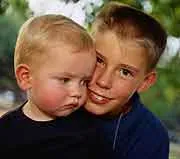About 7 times higher odds seen for full-siblings in large Danish study, lower than other research
WebMD News from HealthDay

By Kathleen Doheny
HealthDay Reporter
MONDAY, Aug. 19 (HealthDay News) -- Children who have an older sibling diagnosed with autism are known to be at higher risk for the disorder themselves, but exactly how much of an increased risk has been debated.
In a large new study, Danish researchers have found that risk, which they call recurrence risk, may be lower than other studies have suggested. "The recurrence risk of autism spectrum disorders is about seven times the risk of the general population," said Therese Koops Gronborg, a Ph.D. student at Aarhus University who led the study.
"But whether that is considered a high or low risk is up to each affected family to decide," she said.
Other studies have pegged the increased risk as high as 19 percent.
Gronborg also evaluated separately children whose older full-siblings and older half-siblings had autism. She found that those with full-siblings with autism had an increased risk of 7.5 percent, while those with half-siblings had a lower risk.
If the children had the same mother, the increased risk was 7.5 percent for full-siblings and 2.4 percent in half-siblings.
If the children had the same father, the risk increased by 7.4 percent for full-siblings but was not significantly increased among half-siblings.
The study evaluated about 1.5 million children born in Denmark between 1980 and 2004 and followed until 2010. It is published online Aug. 19 in JAMA Pediatrics.
The Danish researchers found no time trends over the study period, "suggesting that the factors contributing to the risk for autism recurrence in siblings (perhaps a combination of genes and environment) have not changed over time," Gronborg said.
Autism is a neurodevelopmental disorder marked by difficulties in social interactions and communications. Those affected may also display repetitive behaviors. In the United States, one in 88 children is diagnosed with an autism spectrum disorder (ASD), which encompasses a range of severity. The Danish researchers say the overall risk of ASD for the Danish population is 1.18 percent. The causes of ASD are believed to be genetic and environmental.
The new study results will be valuable to families who have a child already diagnosed with autism, said Dr. Jefry Biehler, chair of pediatrics at Miami Children's Hospital, who was not involved in the study. "Because early intervention and diagnosis are important to the well-being of children, this information can be very important to families who have a child with known autism spectrum disorder," he said.
The overall increased risk found of 7 percent "should be relatively reassuring to families who already have one child with an autism spectrum disorder," said Dr. Andrew Adesman, chief of developmental and behavioral pediatrics at the Steven & Alexandra Cohen Children's Medical Center of New York. However, he added, "there is a possibility that this is an underestimate -- especially for families who have a more severely affected child."
source : Determining Child's Risk When Older Sibling Has Autism








